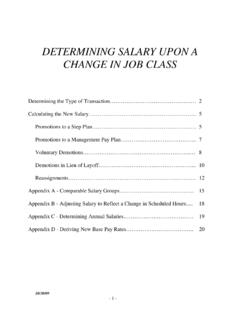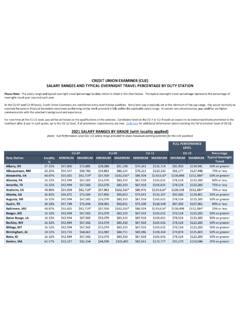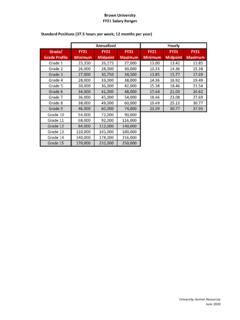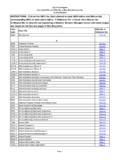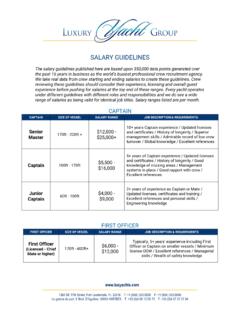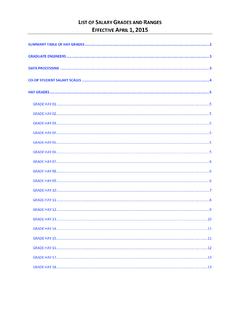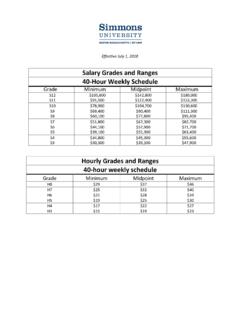Transcription of The Basics of Salary Structure Design & Administration
1 The Basics of Salary Structure Design & Administration Louisiana SHRM Annual Conference 2013 James T Stodd, 2013 1 2 Why Use Pay/ Salary Structures? Market Value $ Job Complexity & Requirements Minimum Wage A Salary Structure defines the relationship between the internal value placed upon jobs within the organization relative to the external value found in the market place. James T Stodd, 2013 Establishing a Base Pay/ Salary Structure James T Stodd, 2013 3 Step 1: Identifying Benchmark Jobs common to organizations within your industry ( , those that provide similar goods and services) or employ comparable workers doing very similar work work performed is very, very standardized from one employer to another, as well as performed under similar working conditions incumbent job requirements ( , knowledge, education, skills, experience, abilities, etc.) are also very standardized from one employer to another is a rich supply of reliable market data for the job James T Stodd, 2013 4 Requirements for good benchmark jobs include the following: Step 2: Collecting Benchmark Data Common Sources of Benchmark Data Bureau of Labor Statistics (BLS) State & Municipal Surveys Surveys (purchased from a private firm for a fee) Sibson Hewitt Wyatt Subscription Services Economic Research Institute (ERI) Business & Legal Resources (BLR) 4.
2 Professional, Industry and Trade Associations 5. Custom-Built Surveys James T Stodd, 2013 5 6 Anatomy of a Pay Range (or Pay Grade) Minimum Maximum Midpoint 1st Quartile 2nd Quartile 3rd Quartile 4th Quartile Market Minimum Market Mean/Median ( Going Rate ) Market Maximum James T Stodd, 2013 The Ideal Case Job Number ofSource25th 75thTitleIncumbents(effective date)LowPercentileAveragePercentileHighA NDJob Number ofSource1st3rdTitleIncumbents(effective date)MinimumQuartileMidpointQuartileMax i mumCurrent Salary /Pay RangePle ase re port in $ ase re port in $ Pay Practices James T Stodd, 2013 7 Common Data Difficulties Source: BLS Occupational Employment & Wages James T Stodd, 2013 8 Common Data Difficulties (Cont d) 10th 25th 75th 90th $36,321 $39,924 $48,520 $52,743 Interpolate Mean/Median? Minimum? Maximum? Source: James T Stodd, 2013 9 Apples to Apples Comparisons Job Number ofSource25th 75thTitleIncumbents(effective date)LowPercentileAveragePercentileHighA NDJob Number ofSource1st3rdTitleIncumbents(effective date)MinimumQuartileMidpointQuartileMaxi mumCurrent Salary /Pay RangePle ase re port in $ ase re port in $ Pay Practices James T Stodd, 2013 10 Adjusting Data for Wage Inflation Sources of information: of Labor Statistics.
3 Employment Cost Index (ECI) Budget & Planning Surveys (must purchase) See Sample: James T Stodd, 2013 11 Sample Budgeting & Planning Survey Custom Survey Questionnaire Reported Job/Position TitleNumber ofJob/Position TitleBasic Summary of Job Duties, Responsibilities & Requirements(in your organization)LowAverageHighIncumbentsExe cutive DirectorThis is the top position responsible for planning, directing, controlling and evaluating all the activities and services of the organization, as well as leading, managing and overseeing those responsible for doing so. Typically this position reports to a Board of Directors. Critical duties and responsibilities include program vision, strategy, goals and objectives, and building an organization capable of for fulfilling those goals and objectives. Additional areas under the executive guidance of this position typically include operations, marketing & community relations, information technology, accounting & finance, information technology, and all other resource and human resource management.
4 Business Office ManagerThis position reports directly to the Executive Director and is responsible for overseeing the normal day-to-day operations of the business office. Principal responsibilities include such duties as accounting, payroll, the preparation of various financial reports, as well as scheduling meetings and preparing items for the governing body. Director of OperationsThis is a managerial position reporting to the Executive Director. Primary responsibilities include assigning resources and manpower to perform service activities. Work involves monitoring performance of subordinate employees, assisting with field activities when necessary, maintaining equipment and supplies. Current Pay PracticesPle ase re port in $ & Salary Survey James T Stodd, 2013 13 14 Typical Pay/ Salary Structure Market Value $ Job Complexity & Requirements Minimum Wage James T Stodd, 2013 15 Method: Too simplistic for growing organizations with multiple jobs System: Very complex and used only by very large/complex organizations ( , federal, state & municipal governments) Method: Complex and rarely used today as most employers have abandoned this approach in favor of the Point-Factor approach Method: Heavily used by larger private or publicly traded business organizations, particularly where there is scarce benchmark data and/or the need for discrete differences between jobs.
5 Requires validated job evaluation plan and ongoing committee involvement to ensure integrity and acceptance of process Salary Table: Very suitable to small and mid-size employers as well as larger organizations that have an abundance of reliable market data for comparable jobs in comparable organizations James T Stodd, 2013 Step 3: Job Evaluation Standard Salary Table applicable to industries where jobs tend to be standardized from one employer to the other and where pay/ Salary data is amply available for those standardized jobs ( , 50% of more of jobs qualify as good benchmark jobs ) simple alternative to the more complicated and time consuming point-factor or factor-comparison approaches approach that relies heavily upon patterns found in market data for development of pay grades and Salary structures established, relatively easy to maintain (compared to other methods) and requires limited (if any) input from external resources useful approach with organizations who s pay practices need to be very market focused and sensitive to the pay practices of others James T Stodd, 2013 16 Determining the Width of Pay ranges 17 *Spread = (Maximum Minimum)
6 /Minimum BENCHMARK JOBLOWMEANHIGHE xecutive Office Network Applications Range (Min to Max) Spread* Data James T Stodd, 2013 Additional first preference should be to use reported pay range data (pay range minimums and maximums), because that is what we are trying to replicate an alternative one might use lowest paid for minimum and highest paid for maximum when a) the employer/survey has not reported an established pay range for the job, and b) the range is not overly restricted James T Stodd, 2013 18 Pay GradeJob/PositionMarket MeanMinimum1st QuartileMidpoint3rd QuartileMaximum1$ $ $ $ $ Worker$ AssistantApplications Technician$ Applications TechnicianDriver-TechnicianMachine TechnicianLead Shop WorkerInspector Assistant5 Senior Applications Technician$ $ $ $ $ $ $ $ $ $ $ $ Supervisor$ $ $ $ $ $ Technologist $ Supervisor$ Network Coordinator$ $ $ $ $ $ $ $ $ $ $ Office Manager$ $ $ $ $ $ $ $ $ $ $ Director $ $ $ $ $ $ $ $ $ $ Salary Table (15% Grade Increments.
7 45% Min-Max Spread)$ $ $ $ $ $ $ $ $ $ $ $ $ $ $ $ x Minimum x James T Stodd, 2013 20 Point Factor Method Point-Factor evaluation plans are used to evaluate jobs based upon several compensable factors recognized by the employer as indicative of job value Most plans measure in some way the following: and Skill and/or Physical Effort and/or Job Impact Conditions Note: These are essentially the same factors considered by the Equal Pay Act The best point-factor plans have been customized to reflect compensation practices by similar organizations employing people in similar roles! 21 Market Value $ Job Evaluation Points (aka Job Value ) Minimum Wage James T Stodd, 2013 Point Factor Method X X X X X X X X X X X X X X X X X X X Point-Factor Plans are validated by regression of market pay data against evaluation points for known benchmark jobs within the industry. Once a Structure is developed, the process is completed by slotting all other jobs based upon evaluation points.
8 Step 4: Implementation/Impact Analysis 22 Pay GradeJob/Position1Be low Minimum1st Quartile2nd Quartile3rd Quartile4th QuartileAbove MaximumShop WorkerXXXXT echnician AssistantXXXXXA pplications TechnicianSpecial Applications TechnicianXXXXXD river-TechnicianXXXXM achine TechnicianXXXXXXXXXLead Shop WorkerXXXI nspector AssistantXXX5 Senior Applications TechnicianXXXX6 InspectorXX7 Shop SupervisorXXChief Technologist XField SupervisorXX9IT Network CoordinatorX1011 Business Office ManagerX1213 Executive Director X2348 Incumbent Analysis23 Period Maintenance Activity Annual a)Adjust pay ranges based upon forecasts of what other employers will be doing during the next year b)Establish and implement Salary increase budget based upon forecasts concerning the type and amount of increases to be granted by similar employers Both these activities will normally involve the use of Salary Budget Surveys, the ECI and CPI Every 3 to 5 years Complete restatement of Salary Structure Step 5.
9 Maintaining the Structure Strategic Pay Administration James T Stodd, 2013 24 25 Market Competitive Strategy Minimum Maximum Midpoint 1st Quartile 2nd Quartile 3rd Quartile 4th Quartile Market Minimum Market Mean/Median ( Going Rate ) Market Maximum James T Stodd, 2013 26 Lead Strategy Minimum Maximum Midpoint 1st Quartile 2nd Quartile 3rd Quartile 4th Quartile Market Minimum Market Mean/Median ( Going Rate ) Market Maximum James T Stodd, 2013 27 Lag Strategy Minimum Maximum Midpoint 1st Quartile 2nd Quartile 3rd Quartile 4th Quartile Market Minimum Market Mean/Median ( Going Rate ) Market Maximum James T Stodd, 2013 28 Broad Band Strategy Minimum Maximum Midpoint 1st Quartile 2nd Quartile 3rd Quartile 4th Quartile Market Minimum Market Mean/Median ( Going Rate ) Market Maximum James T Stodd, 2013 Questions ??? 29 30 Presenter James T. Stodd, SPHR JT Stodd & Associates Office Phone: (225) 290-9866 Email: Website: Jim offers seasoned experience as a strategic and organizational planning consultant, change agent, and executive.
10 He has assisted numerous clients implement the organizational architecture, Structure , infrastructure, and strategic plans required to achieve their visions and goals. In addition, he has assisted other organizations build strategically-focused and highly successful compensation, reward and other human resource management programs by introducing forward thinking approaches to talent management. During his career Jim has served as the Vice President of Human Resources for several prominent organizations including BroMenn Healthcare (Bloomington, IL), Our Lady of the Lake Regional Medical Center (Baton Rouge, LA), and SCAN Health Plan (Long Beach, CA). He has also been associated with several leading consulting firms including Ernst & Young LLP, Hay Management Consultants, and First Transitions. Jim currently maintains an independent consulting practice under the umbrella of JT Stodd & Associates. He has provided consulting services to a diverse mix of clients including those in the healthcare, manufacturing, technology, construction, professional services, petrochemical, finance, education and nonprofit sectors.
